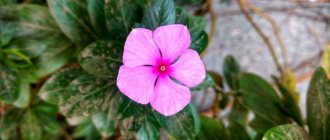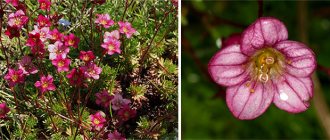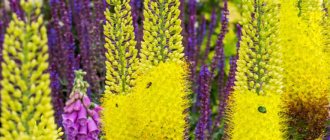Catharanthus is an exotic shrub with long-lasting contrasting flowering. It is also known as cayenne jasmine or pink periwinkle. Its exact origin is unknown, but it is found naturally in Indonesia, India and China, Cuba and the Philippines, as well as Madagascar. However, Catharanthus has adapted well to life in a temperate climate. You can grow it in your own garden and admire the white, red, crimson or purple flowers every year.
Growing in open ground
In nature, catharanthus is represented by tall shrubs up to 150 cm in height. However, at home they reach no more than 60 cm. These are bright ornamental plants that are suitable for growing in open ground, in flower beds and flower beds, in pots and containers.
Guseva Ulyana
Ask a Question
Question to the expert
Is it possible to grow catharanthus outside if the winter temperature drops to -10 degrees?
It is possible, but for the winter it will have to be moved to a warm room.
Previously, catharanthus was considered a houseplant, suitable for growing exclusively at home. The reason is its low resistance to frost . However, it has adapted to a temperate climate, so it can increasingly be found in gardens and flower beds, in single and complex plantings. Caring for it is easy, so even a beginner can handle it.
How to care
Let's find out what kind of care is required for catharanthus growing in the garden.
Watering
The soil in the garden bed needs to be moistened abundantly and often: a tropical flower needs a microclimate saturated with moisture. However, an excess of water should not be allowed - stagnation of liquid in the soil negatively affects the health of the plant. If it’s raining, you don’t have to water it all this time.
Attention: in addition to watering, catharanthus also needs spraying: especially if the weather is hot outside.
Top dressing
Additional nutrition is important for the plant. Fertilizing should begin in the spring, using mineral compounds. When the catharanthus begins to bloom, focus on potassium-phosphorus supplements, which promote more active budding. Application frequency: once every 2-3 weeks. After flowering, you can stop feeding the plant.
In this case, you should be careful when adding organic matter. You can easily exceed the dose, resulting in dangerous burns to the sensitive roots of the plant. If you really want to use organic matter, then choose wood ash: it is both a useful and safe fertilizer. But before adding, be sure to dissolve the ash powder in water.
Trimming
When grown outdoors, catharanthus is rarely pruned: usually indoor plants undergo the procedure. However, if you want to make the shrub more decorative, you can trim it outdoors. The optimal time for the procedure is summer, before flowering.
After pruning, the start of flowering will be postponed a couple of weeks later: during this period, the branching of the bush will increase and the main trunk will become denser.
Reproduction
We examined the process of seed propagation in some detail. But you should know that in addition to seeds, catharanthus can also reproduce vegetatively: by cuttings and dividing the bush.
Cuttings
It is necessary to cut the planting material from the apical part of the mother plant: the survival rate of such cuttings is much higher. The procedure is carried out in the spring and is suitable for indoor catharanthus. As a rule, cuttings take root well and grow their own roots quickly and without any problems.
Dividing the bush
Only adult, overgrown catharanthus undergoes the procedure. Division is carried out in the spring, simultaneously with the next planned transplant. Each division must have its own root system - if this condition is met, it quickly takes root and begins to grow.
Planting catharanthus in open ground
In late spring, plants can be placed in open ground. To do this, you need to wait for a period when the temperature remains at least 20 degrees around the clock . Catharanthus is a tropical plant, so it tolerates prolonged rains and heat, high humidity and bright lighting. In a climate as close as possible to natural, the bushes will grow large, and flowering will be bright and long-lasting. However, without sufficient humidity, direct sunlight can cause burns to leaves and petals. If the summer is dry and watering is carried out artificially, it is worth choosing a site for jasmine in partial shade, with protection from the wind.
In order for plants to take root well in open ground, they are planted according to the instructions:
- dig up a flowerbed to increase the looseness and conductivity of the soil;
- make holes at a distance of 50 cm from each other, into which the rhizome of the seedlings will completely fit;
- add a drainage layer to the bottom of the hole - special expanded clay drainage will do;
- Carefully place the seedling and cover the rhizome with soil;
- water the soil around the plant.
Seeds must be planted in soil well warmed by the sun. Until this point, seedlings can be prepared at home or in a greenhouse.
Reproduction
Catharanthus is propagated by cutting apical stems, planting seeds or dividing the bush. In the spring, dividing an adult bush is easiest to do.
Wintering in open ground
Catharanthus is a tropical plant, so it is difficult to grow outdoors in temperate climates. For flower beds it is easier to choose annual varieties . They are simply sown in the ground, the soil is dug up at the end of the season, and new plants are planted next year. However, there is a way to grow perennial varieties of jasmine. In the fall, after the flowering period has completed (usually in mid-October), you should follow a few simple steps:
- remove the above-ground parts of the plant, leaving no more than 10–15 cm of shoots;
- dig up bushes with rhizomes and move them to a large container - it is important to take into account that the roots grow over the summer, so you need to try not to damage them when replanting;
- place the container with the plant in a warm room for the winter and store at room temperature (optimally 15–17 degrees).
The assortment includes both perennial and annual catharanthus varieties. If the temperature is too low in winter, you should choose annuals for landscaping the flower garden in the warm season.
In winter, all life processes of the catharanthus slow down. During this period, shrubs do not require special care. They are watered only as needed, in small quantities. It is useful to maintain moderate air humidity and ensure that it is not too dry. Experienced gardeners recommend leaving a container of water next to the plants so that they humidify the air.
Description of the plant
The genus Catharanthus (lat. Catharanthus) belongs to the Apocynaceae family and includes annual or perennial herbaceous plants or subshrubs.
Catharanthus means "pure flower" in Greek. This is due to the plant’s ability to cleanse itself of faded flowers, shedding them before they dry out.
The most common species in our gardens is Catharanthus roseus, better known as pink periwinkle, native to the tropics. The popular name pink periwinkle is misleading and comes from Charles Linnaeus's original classification of the species into the genus Vinca (Vinca). Later the genus Catharanthus was isolated. It is an endangered species in the wild and is found in tropical and subtropical areas. As an ornamental potted and greenhouse plant, it is grown in temperate climates.
Carefully! The flower has toxic properties.
Morphology and biology
- Appearance - in natural conditions it is an evergreen shrub up to 80 cm high, with a woody lower part of the shoot, often forming entire thickets. The milky juice of catharanthus is very poisonous. In our climatic conditions, the form is similar to a highly branched subshrub, reaching 30-40 cm.
- The leaves are single, elliptical, shiny, with a clearly visible lighter central vein. Many side shoots develop from the leaf axils.
- Flowers - have 5 petals of different shades of pink or white; neither stamens nor pistil are visible in the center of the flower. There are varieties in cultivation with lilac, peach, and red flowers. Pacific series varieties have flowers with a diameter of 5 cm, Mediteranea has cascading growth. Flowers are pollinated by insects and can self-pollinate. Flowering period of catharanthus: from June to October. Flowers are pollinated by insects, but can also self-pollinate. Unfortunately, the flowers fall off the plant before they wither.
- The fruit is a green leaflet hidden under the leaves. The leaflets contain many grooved seeds. In Madagascar they are spread by ants.
- The root system is branched, with numerous lateral roots, about 30 cm long.
Catharanthus is a poisonous plant; consuming any part can cause hallucinations.
In countries with warm climates (frost hardiness zones 9-12) it is grown as a garden plant. In our country it is grown as a houseplant or potted plant.
Diseases and pests
The main difficulty when growing ornamental plants is various diseases and pests. They can appear even with good care and affect healthy, viable bushes. The main thing is not to get lost and protect the flower beds with catharanthus in time. A disease or pest type can be identified by its symptoms.
It is optimal to treat catharanthus bushes regularly, according to the instructions. Purchased insecticides will protect plants from dangerous diseases.
Fungal diseases
The fungus can affect both the above-ground parts of the plant and the rhizome. The main reason for its spread is insufficient drainage during abundant watering or in rainy weather . It causes various diseases, including gray and brown spot. Light or dark spots with jagged edges appear on the leaves. They quickly increase in size and can merge into large spots. In addition, the bushes lag behind in growth, stop blooming and form new buds.
general information
Catharanthus impress with their versatility and unpretentiousness. In the garden it is a wonderful seasonal annual, and in the room it is an amazing decoration for any apartment. Delicate flowers of 5 petals with a bright center are painted in all shades of pink.
In its natural environment, catharanthus grows as a perennial, so it manages to grow up to 1.5 m. In our latitudes it is much more compact - about 60 cm. It has been cultivated for several centuries, and during this time many ornamental varieties have appeared.
A powerful root system allows the plant to survive under unfavorable conditions, but requires space. Dark leaves with light veins are very graceful and beautiful. The diameter of the flowers ranges on average from 3 to 5 mm.
Photo: violet-bryansk.ru
Possible problems when growing catharanthus
Recommended by topic
Hydrangea Hippeastrum Dormant period for indoor plants: a detailed guide
Under normal conditions, catharanthus bushes grow quickly and bloom brightly throughout the summer. However, even in caring hands, the plant may need certain supplements or regime adjustments. To detect in time that flowers are beginning to complain of poor health, it is enough to pay attention to their appearance.
- Leaves that are too soft are a reaction to excess sunlight. Despite the tropical origin of the plant, in nature the bushes choose forest areas. If plants do not feel well in open sunlight, you can build an awning for them that will protect them from too bright light.
- Yellowing of the tips of the leaves is a response to insufficient air humidity. This can be easily corrected by regularly spraying the leaves and shoots in the morning or evening.
- The lower layer of leaves turns yellow and falls off - a natural phenomenon. The plant spends its main energy on the formation of new shoots, blossoming of shoots and flowering. Fallen leaves can be easily removed.
- Insufficient flowering or its absence is a reaction to a period of cooling. Flowers will bloom if it gets warmer.
- The plant stops growing and blooming, turns yellow - there is not enough space for the rhizome to grow. This problem is more common in catharanthus that are kept in pots at home. If neighboring bushes are too crowded, they can be planted at a greater distance.
Not all changes that may frighten a beginner actually indicate a danger to plant health. Some of them are a natural process of growth and development. Yellowed or dry areas can be removed to maintain a neat appearance of the plant.
What should the soil be like?
The indoor plant will be well-groomed and will enchant with lush flowering if purchased fertile soil is used, or a mixture of turf, deciduous soil with peat. Of course, for intensive growth, catharanthus needs fertilizing so that the soil is not depleted. In spring and late summer, you can use fertilizers for blooming indoor flowers.
Use in landscape design
Catharanthus is an unusual solution for decorating flower beds, flower beds, and summer cottages. Bright
There are several options for growing catharanthus in open ground:
- flower beds using catharanthus and other types of flowering plants;
- independent planting in a bright flower garden;
- living borders; overhead growing - in containers that are located on a hill, on fences, gazebos or building facades.
Catharanthus can also be grown in urban environments. However, the plant needs good care and abundant watering. In municipal flower beds and recreation areas, cayenne jasmine may not reveal all its decorative qualities if it does not receive enough attention.
Interesting varieties
Different varieties of catharanthus have flowers that are usually pink or purple, but can be white, red, or lilac. There are also varieties with two-color flowers or decorated with an eye of a contrasting color.
A lot of varieties have been bred, thanks to which this plant can be grown in our climate as an annual.
Interesting varieties of catharanthus:
- "Pacific" Pacific - a variety with very large flowers (5 cm in diameter);
- Peppermint Cooler - with two-tone flowers decorated with a contrasting eye.
There are several groups of varieties and hybrids on the market. Modern hybrids (F1) branch better, produce larger flowers, bloom earlier (about two weeks) and last longer. Examples of variety groups:
- Blockbuster F1 (Floranova) - produces exceptionally large flowers even in the worst growing conditions. The plants are compact, branch well, and produce brightly colored flowers.
- Cora F1 (Syngenta Flowers) produces very large flowers, has good branching, and is resistant to pathogens of the genus Phytophthora spp.
- Cora Cascade F1 – this hanging catharanthus looks great planted in hanging containers.
Photo. Varieties of hanging catharanthus “Cora Cascade” F1
The Mediterranean XP (PanAmerican Seed) group includes hanging varieties suitable for growing in hanging containers. Plants grow vigorously and branch well, quickly covering the surface of the substrate and pot. The flowers are large, numerous, attractively colored.
Photo. Burgundy Halo variety from the Mediterranean XP group
Interesting varieties from the “Tattoo” group with original flower colors.
The varieties of the Titan F1 group are very uniform in growth and flowering, produce large flowers of typical color, they are ideal for urban plantings.
The varieties of the Valiant F1 group are vigorous, branch well and produce large flowers (five bright colors). As unpretentious plants, they work well in green spaces. They exhibit resistance to pathogens of the genus Phytophthora spp, salinity, drought and heat.
Beneficial features
Photo of catharanthus rosea
Despite the fact that all organs of the plant are poisonous, catharanthus has been used since ancient times in folk medicine, and in modern conditions, also in professional medicine. The juice contains biologically active substances - alkaloids, which are included in many medications. When used correctly under medical supervision, they:
- reduce blood sugar levels;
- have anti-cancer properties, reduce the size of tumors and polyps;
- heal wounds and ulcers, skin diseases;
- treat respiratory diseases, oral diseases, hypertension.











